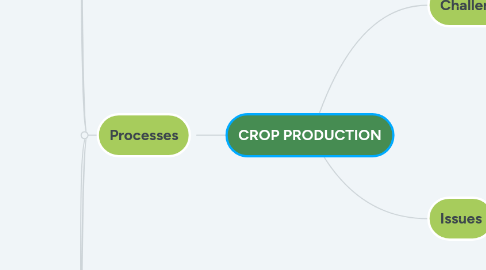
1. Challenges
1.1. Pre-COVID
1.1.1. Producing more diverse, healthy, safer, and nutritious food
1.2. During COVID
1.2.1. Food access concerns
1.2.2. Food production
1.3. Chronic challenges
1.3.1. Low productivity and income
1.3.2. Climate change
1.3.3. Food diversity
2. Issues
2.1. Global
2.1.1. Increasing demand and consumption
2.1.2. Narrowed food diversity
2.1.3. Adaptability and suitability of crops
2.1.4. Adverse environmental effects
2.1.5. Complicated food supply chain
2.2. Local
2.2.1. Combatting malnutrition
2.2.2. National food security
2.2.3. Sustainability of agriculture
2.2.4. Poverty among farmers
2.2.5. Inflation
3. Processes
3.1. 1. Site selection and evaluation
3.1.1. Approaches
3.1.1.1. Identified crop before selecting site
3.1.1.1.1. 1. Crop feasibility study
3.1.1.1.2. 2. Site determination
3.1.1.2. Identified site before selecting crop
3.1.1.2.1. 1. Site characterization
3.1.1.2.2. 2. Crop identification
3.1.2. Factors to consider
3.1.2.1. Good location
3.1.2.1.1. Infrastructures
3.1.2.1.2. Socio-economic condition
3.1.2.2. Suitable soil
3.1.2.2.1. Texture, structure, pH, depth, nutrient content
3.1.2.3. Favorable climate
3.1.2.3.1. Temperature
3.1.2.3.2. Light
3.1.2.3.3. Rainfall
3.1.2.3.4. Climate type
3.2. 2. Land preparation
3.2.1. Methods
3.2.1.1. Conventional method
3.2.1.1.1. Lowland crops
3.2.1.2. Minimum tillage/No tillage
3.2.1.2.1. Upland crops
3.2.1.2.2. Hilly land
3.3. 3. Crop establishment
3.3.1. 3.1. Selection and preparation of planting materials
3.3.1.1. Sexual propagation
3.3.1.1.1. Seed treatments
3.3.1.1.2. Rootstock seedlings
3.3.1.1.3. Vegetable seedlings
3.3.1.2. Asexual propagation
3.3.1.2.1. stems
3.3.1.2.2. roots
3.3.1.2.3. leaves
3.3.1.3. Grafting
3.3.2. 3.2. Laying out
3.3.2.1. Planting distance
3.3.2.2. Planting systems
3.3.2.2.1. Square
3.3.2.2.2. Triangular
3.3.2.2.3. Quincunx
3.3.2.2.4. Contour
3.3.2.3. Population density
3.3.2.3.1. Factors
3.3.2.3.2. Cropping system
3.3.3. 3.3. Planting operations
3.3.3.1. Direct seeding
3.3.3.1.1. Broadcasting
3.3.3.1.2. Hill method
3.3.3.1.3. Drill method
3.3.3.1.4. Dibble
3.3.3.2. Transplanting
3.4. 4. Care and maintenance
3.4.1. 4.1. Special practices
3.4.1.1. Chemical methods
3.4.1.1.1. Plant Growth Regulators
3.4.1.2. Physical methods
3.4.1.2.1. • Pruning
3.4.1.2.2. • Windbreak establishment
3.4.1.2.3. • Smudging
3.4.1.2.4. • Girdling
3.4.1.2.5. • Training
3.4.2. 4.2 Nutrition
3.4.2.1. Soil nutrient
3.4.2.1.1. Available
3.4.2.1.2. Loss
3.4.2.1.3. Addition
3.4.3. 4.3 Pest management
3.4.3.1. Pest types
3.4.3.1.1. Pathogens
3.4.3.1.2. Insect and mites
3.4.3.1.3. Weeds
3.4.3.1.4. Vertebrate pests
3.4.3.2. Controls
3.4.3.2.1. Genotypical
3.4.3.2.2. Biological
3.4.3.2.3. Physical
3.4.3.2.4. Cultural
3.4.3.2.5. Chemical
3.5. 5. Harvesting
3.5.1. Approach
3.5.1.1. Manual
3.5.1.2. Conveyor-aided
3.5.1.3. Mechanical
3.5.2. Methods
3.5.2.1. Priming
3.5.2.2. Stripping
3.5.2.3. Tapping
3.5.3. Maturity indices
3.5.3.1. Visual
3.5.3.2. Physical
3.5.3.3. Compositional
3.5.3.4. Phenological
3.6. 6. Postharvest handling
3.6.1. Perishables
3.6.1.1. Trimming
3.6.1.2. Cleaning
3.6.1.3. Sorting
3.6.1.4. Grading
3.6.1.5. Coating
3.6.1.6. Ripening
3.6.1.6.1. Ethylene gas
3.6.1.6.2. Acetylene
3.6.1.6.3. Bioethylene
3.6.1.6.4. Smoking
3.6.1.7. Packaging
3.6.1.7.1. Flexible
3.6.1.7.2. Semi-rigid
3.6.1.7.3. Rigid
3.6.2. Durables
3.6.2.1. Primary processing
3.6.2.1.1. Extracting
3.6.2.1.2. Drying
3.6.2.1.3. Fermentation
